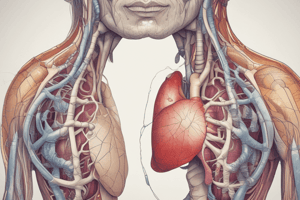Podcast
Questions and Answers
What are the three main functions of respiration?
What are the three main functions of respiration?
- Supplying oxygen to tissues (correct)
- Regulation of pH of blood (correct)
- Elimination of carbon dioxide from tissues (correct)
- Maintaining normal body temperature
What are the three processes included in respiration?
What are the three processes included in respiration?
External respiration, Transport of respiratory gases, Internal respiration
The wall of the conducting zone is thick and does not allow gas exchange, and includes passages such as nose, pharynx, and ____________.
The wall of the conducting zone is thick and does not allow gas exchange, and includes passages such as nose, pharynx, and ____________.
trachea
Alveoli are responsible for gas exchange and are located in the conducting zone of the lungs.
Alveoli are responsible for gas exchange and are located in the conducting zone of the lungs.
Match the following lung capacities with their definitions:
Match the following lung capacities with their definitions:
Flashcards are hidden until you start studying
Study Notes
Respiration
- Respiration includes three processes: external respiration, transport of respiratory gases, and internal respiration.
- The main functions of respiration are to supply tissues with oxygen and eliminate carbon dioxide from tissues, regulate blood pH, and maintain normal body temperature.
External Respiration
- External respiration includes pulmonary ventilation and the exchange of gases between alveolar air and venous blood in capillaries around alveoli.
- Pulmonary ventilation is the renewal of oxygen in the lungs from the atmosphere.
Transport of Respiratory Gases
- Transport of respiratory gases involves the carriage of oxygen to tissues and carbon dioxide to the lungs by blood.
Internal Respiration
- Internal respiration is the exchange of gases between blood in capillaries and cells of tissues, as well as the oxidation of food by oxygen in tissues producing energy required for body activities.
Anatomy of the Respiratory System
- The respiratory system consists of air passages, lungs, and respiratory muscles (diaphragm and intercostal muscles).
- Air passages include the nose, pharynx, larynx, trachea, bronchi, bronchioles, and alveoli.
Respiratory Passages
- The pharynx is a common passage for air and food.
- The epiglottis is a flap of cartilage lying behind the tongue and in front of the entrance to the larynx.
Trachea and Bronchi
- The trachea is a tube 2 cm in diameter and 10 cm long, kept open by incomplete rings of cartilage.
Alveoli, Alveolar Sacs, and Alveolar Ducts
- Alveolar ducts are long, branching passages that arise from respiratory bronchioles.
- Alveolar sacs are groups of alveoli that open into a common central space (the atrium).
Zones of the Respiratory System
- The conducting zone includes passages (nose, pharynx, trachea) and has a thick wall that does not allow gas exchange.
- The respiratory zone consists of respiratory units, including bronchioles (subdivided into alveolar ducts and clusters of alveoli).
Alveoli
- Alveoli are minute "air spaces" that open into the alveolar ducts and, to a lesser extent, into the respiratory bronchioles.
- Each alveolus is wrapped in a fine mesh of capillaries covering about 70% of its area.
- A typical pair of human lungs contains about 700 million alveoli, producing 70m2 of surface area.
Lungs
- The lungs are paired organs in the chest that perform respiration.
- In humans, there are two lungs, each located in one side of the thoracic cavity.
- The right lung has 3 lobes and 2 fissures, while the left lung has 2 lobes and 1 fissure.
Pleura
- The pleura is a thin, double membrane that invests the lung, consisting of parietal and visceral pleura.
- The two pleurae are separated by a thin film of fluid for lubrication of sliding movements.
Mechanism of Respiration (Breathing)
- Respiration occurs by changes in the size of the thoracic cavity and lungs, followed by the activity of respiratory muscles (diaphragm and intercostal muscles).
- Normal breathing (respiration) consists of active inspiration followed by passive expiration.
Volume of Respiratory Air
- The volume of respiratory air can be measured using a spirometer.
- Tidal air volume (TV) is the volume of air breathed in and out in a single quiet respiration (about 500 ml).
- Inspiratory reserve volume (IRV) is the volume of air taken by the deepest inspiration more than the tidal air (about 3000 ml).
- Expiratory reserve volume (ERV) is the volume of air given off by the deepest expiration more than the tidal air (about 1200 ml).
- Residual air volume (RV) is the volume of air that remains in the lungs after maximal expiration (about 1200 ml).
Lung Capacity
- Total lung capacity (TLC) is the volume of air contained in the lungs after the deepest (maximal) inspiration (about 6000 ml or 6 liters).
- Functional residual capacity (FRC) is the volume of air remaining in the lungs after a normal expiration (about 1200 + 1200 = 2400 ml).
- Inspiratory capacity is the volume of air taken by maximal inspiration at the end of normal expiration (about 3500 ml).
- Expiratory capacity is the volume of air obtained by maximal expiration after normal inspiration (about 1700 ml).
- Vital capacity is the volume of air exhaled by a maximal expiration after a maximal inspiration (about 4700 ml or 5 liters).
Studying That Suits You
Use AI to generate personalized quizzes and flashcards to suit your learning preferences.




